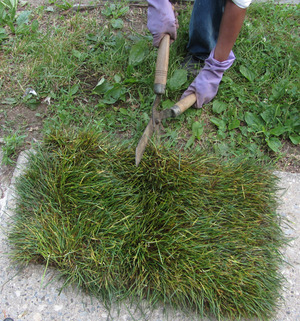Gather Your Tools. You’ll need 1) a trowel, pointed shovel, or pitchfork 2) a tine rake (heavy rake) 3) grass shears, utility knife, or garden shears and 4) gardening gloves.
Prepare the Soil. Use a trowel, pitchfork, or pointed shovel to pierce the top two or three inches of the soil of the area you’re repairing and turn it over. Break up large clumps of soil. Level the loosened soil with the back end of the tine rake.
Buy the Sod. Buy sod from a supplier that sells a quality product, which means the sod is free of weeds. Reputable sod farmers sell weed – free products. They have a reputation to maintain. You don’t want to work hard in laying the sod and then have your work ruined by unsightly weeds. Even if you don’t lay the sod iimmediately, water it everyday. Ideally, try to lay the sod within a day or two of purchase. And if you have a tall stack of sod, it’s a good idea to rotate the pieces when watering so even the bottom pieces get a good watering if it’s going to be days before you lay the sod.
Sod is a good choice over grass seed because once you’ve patched a lawn with sod that’s rooted and grown for a short time, it’s difficult to tell where the patching occurred. Patching with grass seed, however, often gives the lawn a patched look for a long time.
Lay the Sod. Put a piece of sod on top of the prepared soil. If it sits above the existing grass, remove some soil. Since a piece of sod is about two inches thick, you might have to remove some soil. And if the area you’re preparing is low, you will have to add soil. I’ve done this and I’ve simply used some of the soil I removed from another area of the lawn I was repairing that was too high. If no yard soil is available, buy topsoil or sand. Once I had a large area of my yard repaired by a gardener who trucked in sand to fill low areas before laying sod. The results were excellent. Now that the sod lays correctly, place the other pieces horizontally end – to – end.
Once you think the sod is level, set it in place by gently pushing it down with the back end of the rake or stepping lightly on it. Add or remove soil as necessary.
Cut the Sod. If you need to cut a piece of sod to make it fit, use a utility knife, grass shears, or
garden shears.
Anchor the Sod. If the sod is in a heavy traffic area, use garden staples, landscape pins, or crampons to keep it in placed while it’s rooting.
Water the Sod. Water the sod daily until it’s rooted. This can take two to four weeks. Morning is the best time to water because it’s usually the coolest part of the day and the time of minimal winds.
Sod is the correct choice for repairing spots in lawns that need the quick fix that grass seed doesn’t offer. For example, if soil is running off a sloped area because no grass is there, lay sod to stop the eroision quickly.


